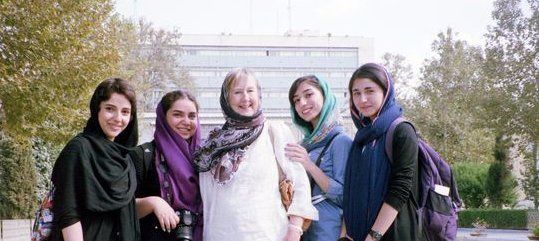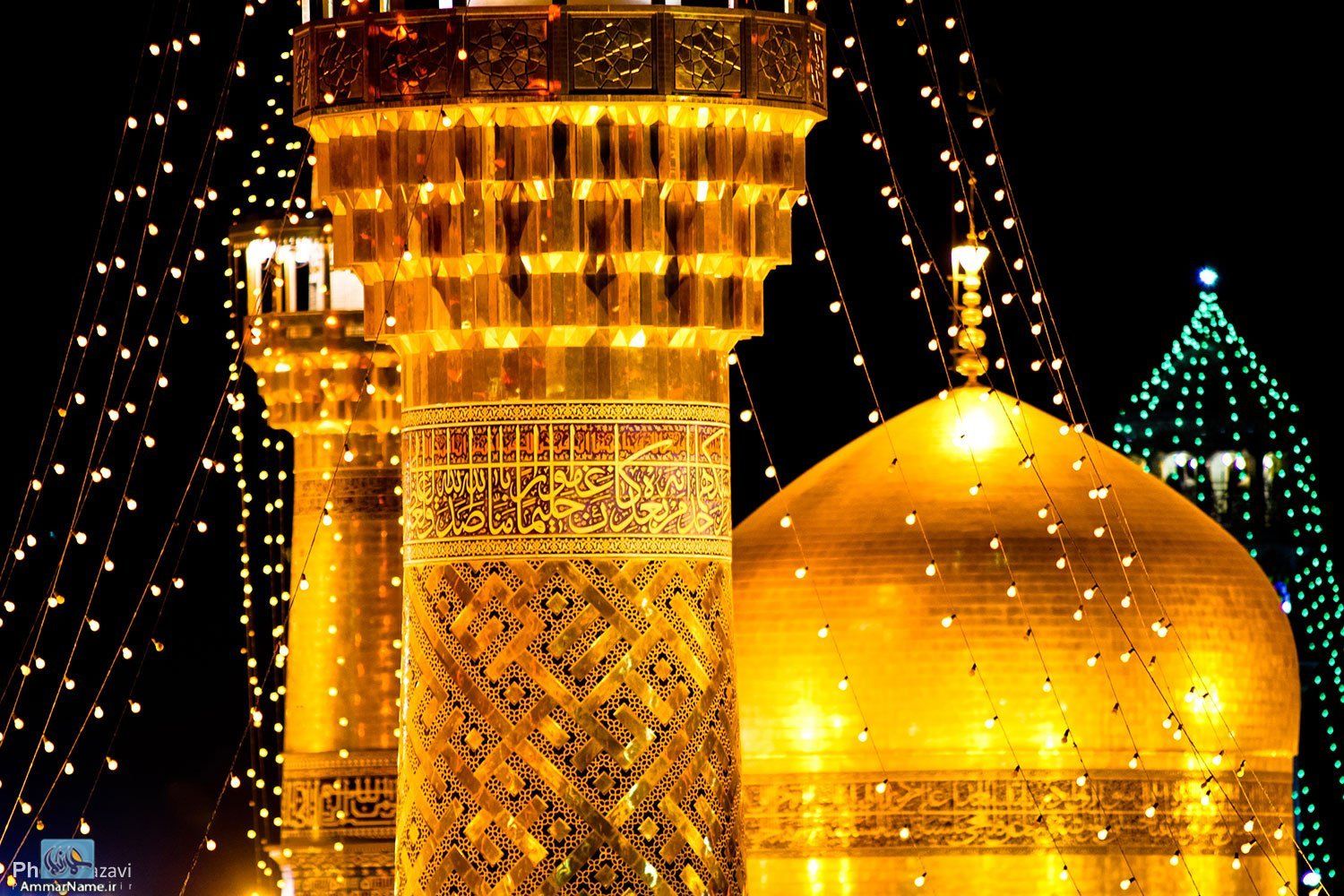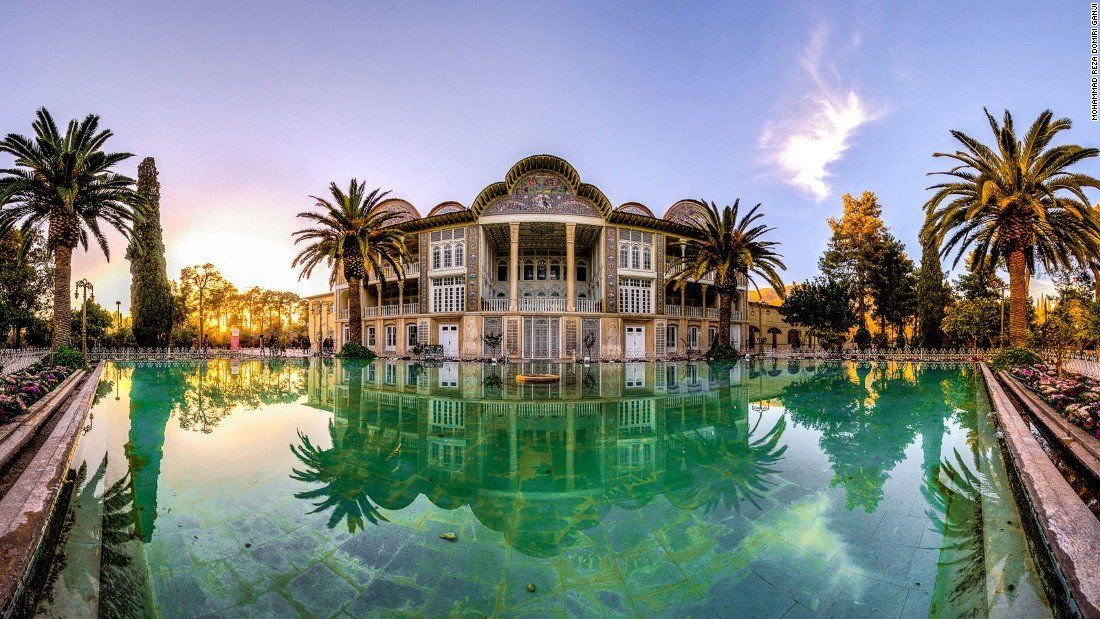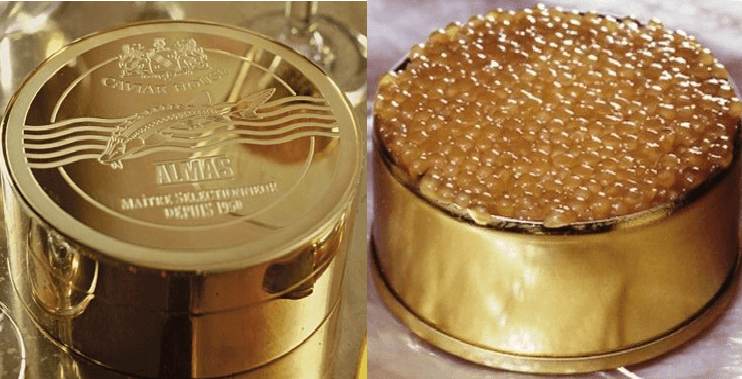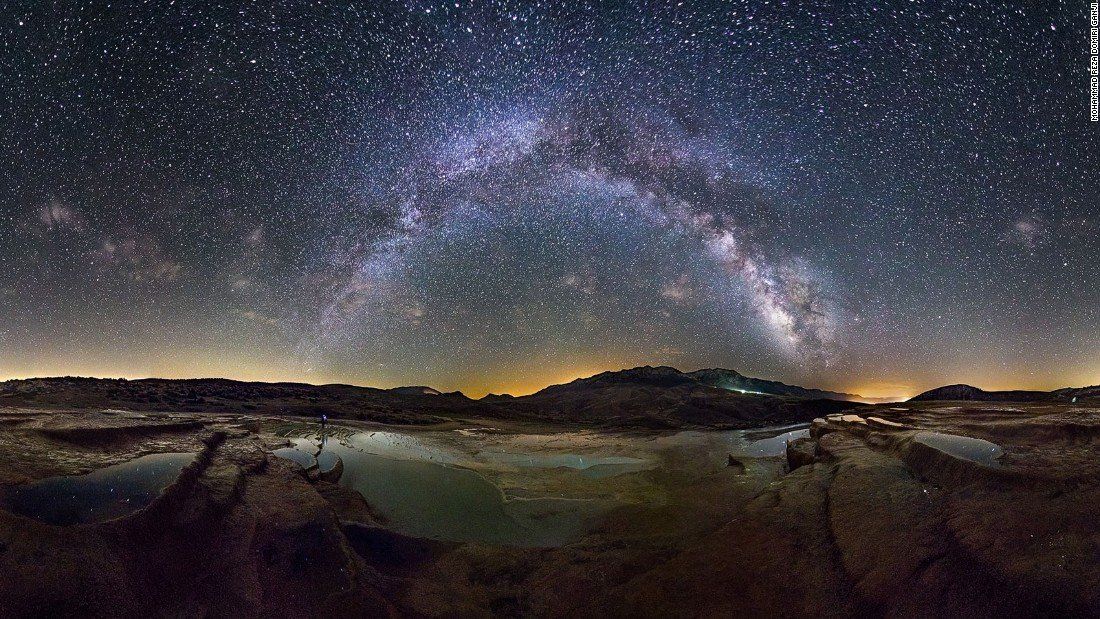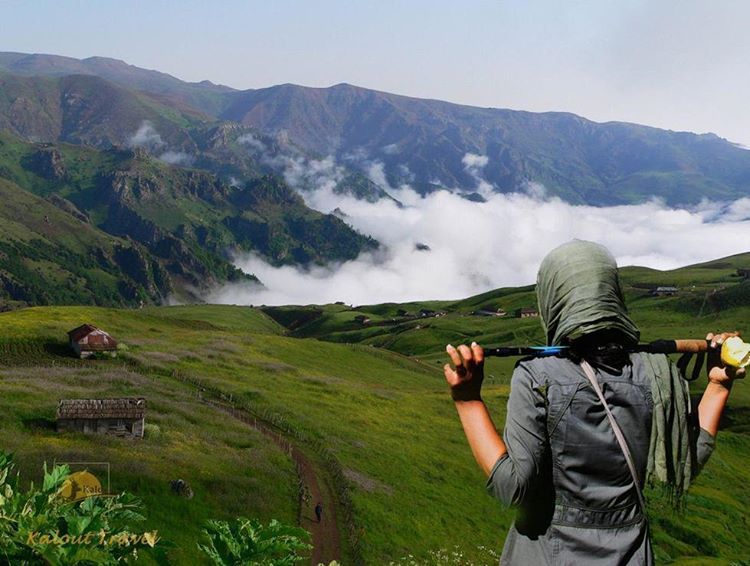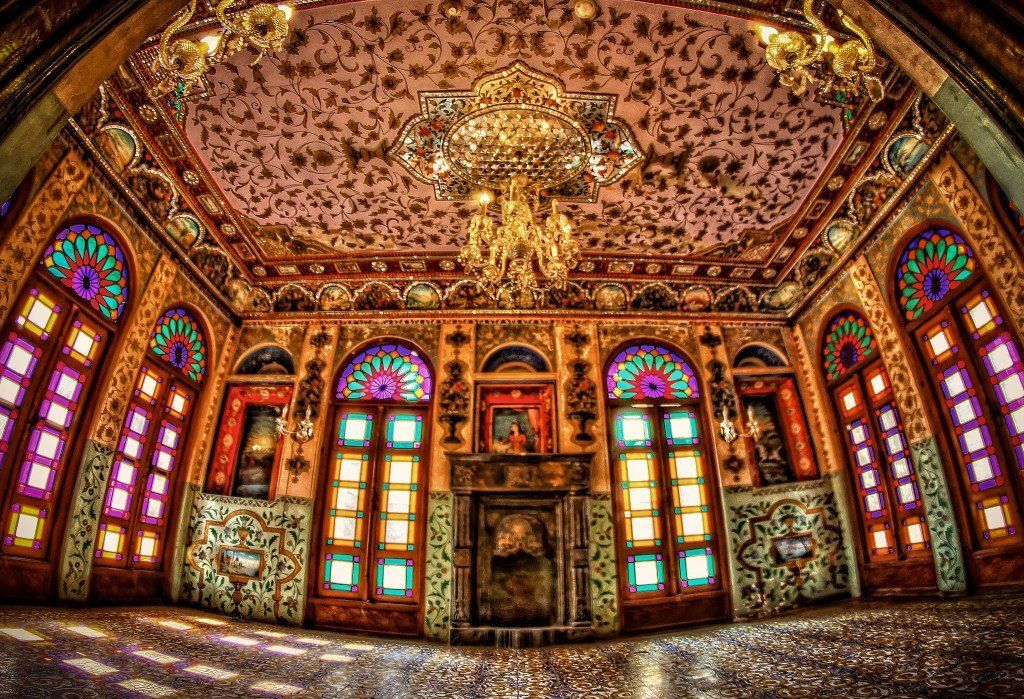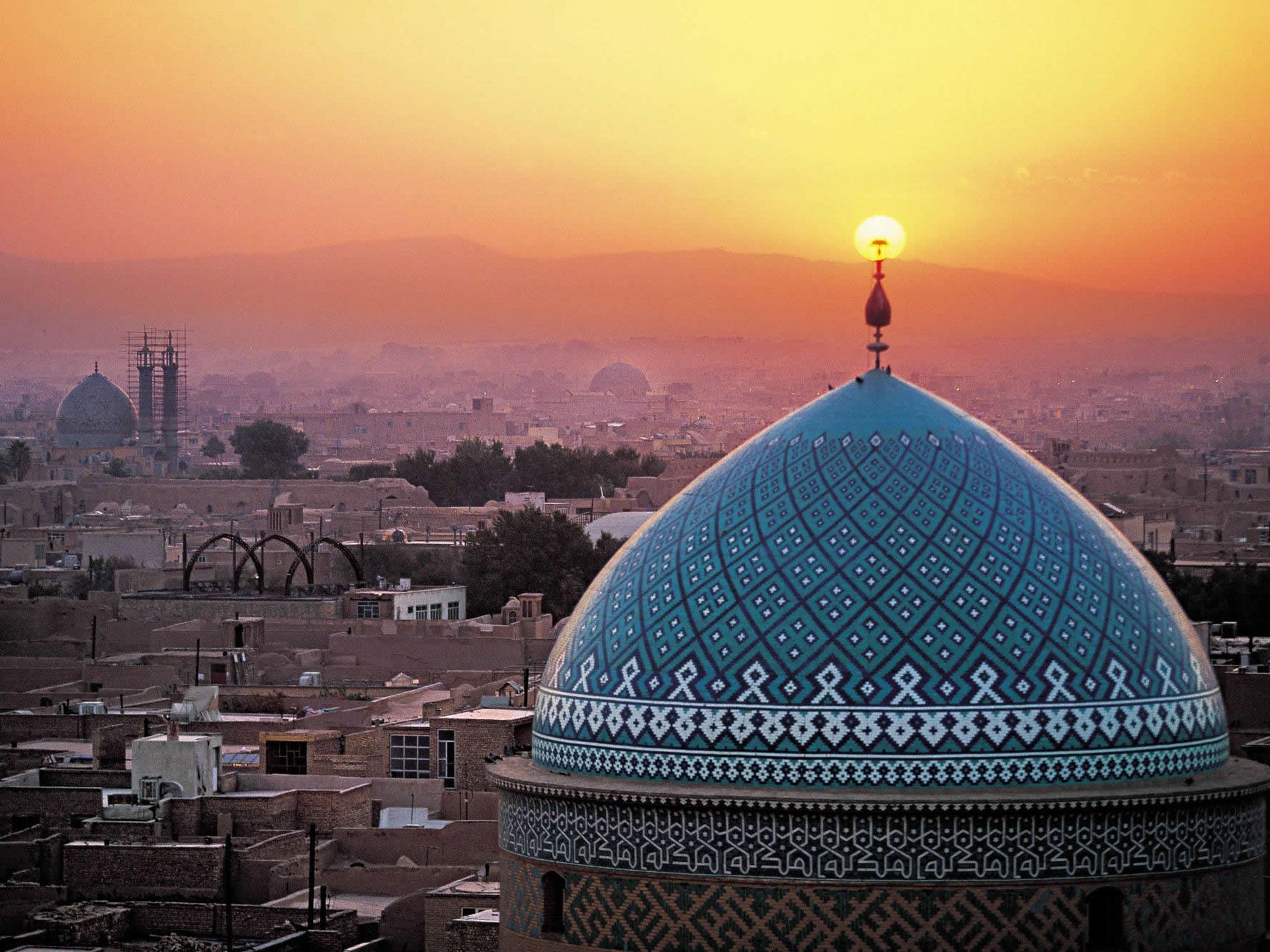Imam Reza Holy Shrine
The Imam Reza shrine (Persian: حرم امام رضا) in Mashhad, Iran is a complex which contains the mausoleum of Imam Reza, the eighth Imam of Twelver Shiites. It is the largest mosque in the world by dimension and the second largest by capacity. Also contained within the complex are the Goharshad Mosque, a museum, a library, four seminaries, a cemetery, the Razavi University of Islamic Sciences, a dining hall for pilgrims, vast prayer halls, and other buildings.
The complex is one of the tourism centers in Iran. The shrine itself covers an area of 267,079m2 while the seven courtyards which surround it cover an area of 331,578m2 - totaling 598,657 m2 (6,443,890 sq ft).
Every year the ceremony of Dust Clearing is celebrated in the Imam Reza shrine.
1 History
1.1 Early years
1.3 Ghaznevid era
1.4 Saljug era
1.5 Mongol invasion
1.6 Timurid era
1.7 Safavid era
1.9 Modern era
2.1.1 Sahn Inqilab
2.1.2 Sahn Jumhuri Islami
2.1.3 Sahn Quds
2.1.4 Sahn Imam Khomeini
2.1.5 Sahn Azadi
2.2 Minarets
2.6 Halls
2.7 Goharshad Mosque
2.10 Dar-al-Siyadah
2.11 Bala-Sar Mosque
2.12 Dar-al Rahmah Porch
2.13 Allahverdi Khan Dome
2.14 Hatam Khani Dome
2.15 The Golden Dome
2.16 Astan Quds Museum
2.17 Museum of The Quran
2.18 Museum of Stamps
Panoramic view over just part of Imam Reza Holy Shrine
History
Early years
Dar-ul-Imarah (Royal Residence) or the garden of Hamid-Ibn-Qahtabeye Taii was a fortress in the village of Sanabad. It dates back to the era before the Islam religion. It had been placed at the fork road of Sanabad, Neishabour, Sarakhs, Toos and Radkan. In fact, this fortress has been a place for the frontier guards to take position and establish the security of these roads and regions. After the demise of Harun al-Rashid, he was buried in this place. Due to this historical event, the Dar-ul-Imarah was known as the Mausoleum of Haruniyyeh.
The original inner building of Dar-ul-Imarah has been in fact a temple used by the Zoroastrians to worship. This building was demolished by the order of al-Ma'mun, and then it was reconstructed according to the special architecture of Khorasan. Four plain and short walls, covered with a low-slope dome, were constructed around the building. Afterwards, the name of the mausoleum (Haruniyyeh) was changed and known as the Mashhad-ur-Reza, due to the Holy Imam. Mashhad literally means a place where a martyr has been buried.
Martyrdom of Ali al-Ridha
In 818, the Alid Imam Ali al-Ridha was murdered by the Abbasid caliph al-Ma'mun (ruled 813–833) and was buried beside the grave of al-Ma'mun's father, Harun al-Rashid (r. 786–809). After this event, the location was called as Mashhad al-Ridha ("the place of martyrdom of al-Ridha"). Shias and Sunnis began visiting his grave on pilgrimage. By the end of the 9th century a dome was built on the grave and many buildings and bazaars sprang up around it. For the next thousand years, it has been devastated and reconstructed several times.
In 993 the holy shrine was ruined by Saboktakin, a Ghaznavid king. However, in 1009, his son Sultan Mahmud of Ghazni ordered the shrine to be repaired and expanded. About 1150 Sultan Sanjar, a Seljuq king, renovated the sanctuary and added new buildings after his son was miraculously healed at the shrine. Later, Sultan Muhammad Khodabande, an Ilkhanate king who converted to Shiism, renovated the holy shrine around 1310. The celebrated Muslim traveler Ibn Battuta visited Mashhad in 1333 and reported that it was a large town with abundant fruit trees, streams and mills. A great dome of elegant construction surmounts the noble mausoleum, the walls being decorated with colored tiles. Opposite the tomb of the Imam is the tomb of Caliph Harun al-Rashid, which is surmounted by a platform bearing chandeliers. However, the tomb of Harun al-Rashid is not considered sacred, as he was responsible for the murders of the 6th and 7th Shia Imams.
Ghaznevid era
By the end of the third century Hijrah, a dome was built on the grave of Imam Reza and many buildings and bazaars sprang around the holy shrine. Followers of the Ahl al-Bayt from various parts of the world started visiting Mashhad for pilgrimage. In 383 A.H. / 993 A.D., Sebuktigin, the Ghaznevid sultan devastated Mashhad and stopped the pilgrims from visiting the holy shrine of Imam Reza. But in 400 A.H./ 1009 A.D., Mahmud of Ghazni (born 971, ruled, 998-1030 A.D.,) started the expansion and renovation of the holy shrine and built many fortifications around the city.
The holy shrine was decorated with fine marbles, quality wooden and stucco works. Mahmud of Ghazni also built the burial chamber on the grave of Imam Reza. This square-shaped building which constitutes the center of the shrine, before adding decorations and additional parts, had been apparently similar to Sang Bast (Tomb of Arsalan Jadhib), because of their simultaneity. According to the earliest tomb inscription of Imam Reza, kept in Astan Quds Razavi museum, then the shrine construction might have been reconstructed or repaired in 516/1122. This building was damaged severely during the Ghuzz invasion in 548/1153. After him his son Masud (b. 998 A.D., r. 1030-1040 A.D.) built a wall around the holy shrine and further beautified the holy shrine.
Panoramic view over just part of Imam Reza Holy Shrine
Saljug era
Sultan Sanjar (b. 1086 A.D., r. 1097-1157 A.D.), after the miraculous healing of his son in the holy shrine of Imam Reza, renovated the sanctuary and added new buildings within its precincts. At the time of Sultan Sanjar Saljuqi, after Sharaf al-Din Abu Tahir b. Sa'd b. Ali Qummi repaired the shrine, he began to construct a dome over it. Later, in 557/1162, however, Chatrgan Zumurrud Malik, daughter of Mahmud I of Great Seljuq, decorated the dadoes with precious hexangular, octagonal and star-shaped tiles. Her name and the date of decoration were inscribed on the tiles.
In 612 A.H./ 1215 A.D., as borne out by inscriptions on certain tiles, Allaudin Khwarezm Shah carried out renovations on the shrine. Two of the prayer niches, embellished with elegant porcelain tiles, as well as those with Kufic inscriptions that adorn the walls to the upper side of the holy burial chamber, bear the name of his vezir Ali bin Muhammad Muqri. A couplet in Persian by Abdullah bin Muhammad bin Abdullah on the wall also carries the date 612 A.H.
Mongol invasion
During Khwarazm-Shahs period, Razavi Shrine was paid much attention and some repairment and decoration were made in it. In this era(612/1215), two very glorious embossed Thuluth (a large Naskh handwriting) inscriptions in form of square tile work were fixed on both sides of the shrine entrance-by the side of Dar al-Huffaz porch—in which the names and descent of Imam Reza back to Imam Ali were written. Some other inscriptions and three mihrabs (a special place for prayer-leader in mosques) belonging to this age exist in this holy complex.
During the Mongol invasion in 1220 AD (617 A.H.), Khorasan was plundered by the invading hordes and the survivors of this massacre took refuge in Mashhad and settled around the holy shrine. Sultan Muhammad Khudabandeh Iljaitu (b. 1282 AD), the Mongol ruler of Iran, converted to Shi'ism and ruled Iran in 703–716 A.H (1304–1316 AD), once again renovated the holy shrine on a grand scale. Ibn Batutah, who visited Mashhad in 734/1333, mentioned the nice tile decorated building of the shrine and silver Zareeh (burial chamber) over the tomb which might have been built in Iljaitu's period. It also seems that the complete construction of the present dome is one of Iljaitu's services. In 791 A.H., Miran Shah the son of Tamerlane (born 1336 AD, r. 1370–1404 AD) razed Toos to its foundation and massacred its inhabitants. Toos lost its popularity. and as a result the holy city of Mashhad rose to prominence contributing to the gradual emergence of Mashhad as a major city.
Timurid era
The glorious phase of Mashhad started during the reign of Shahrukh Mirza (b. 1377 A.D., r, 1405-1447) son of Tamerlane and reached its zenith during the reign of Safavid kings who ruled Iran from 1501-1786 A.D. Shahrukh Mirza, whose capital was Herat, regularly visited Mashhad for the pilgrimage of the holy shrine of Imam Reza (A.S.). In the 15th century, during the reign of the Timurid Shahrukh Mirza, Masshad became one of the main cities of the realm. In 1418, his wife Empress Goharshad funded the construction of an outstanding mosque beside the shrine, which is known as the Goharshad Mosque.
Timurid era
In 8th/14th century, buildings of Astan Quds Razavi included: the Shrine, Bala Sar Mosque (constructed by Abu-al Hassan Iraqi, one of the clerks in Ghaznavi period), some small buildings attached to the north side of the Shrine, and a seminary. Then, Dar al- Huffaz, between the shrine and the Mosque, Dar al-Siyadah on the west side of Dar al- Huffaz, and finally "Tawhid Khanah" or "Khazanah" (public treasury) were built on the east side. In addition, three seminaries: Madrisah Parizad, Madrisah Bala Sar, and Madrisah Du Dar were built round the above-mentioned complex during Shahrukh's rule.
In Sultan Hussein Bayqara's era (875/1470-912/1506), Sahn Atiq (the old courtyard) and the main building of the golden porch were founded by Amir 'Ali Shir Nava'ii. With the emergence of the Safavid dynasty in 1501 A.D. and their declaration of the Shi'ite school as the state religion, Mashhad reached the peak of its development and soon became one of the greatest sites of pilgrimage. However, since Khorasan was a border province of the Safavid Empire, Mashhad consequently suffered repeated invasions and periods of occupation by the Uzbek Khans - Muhammad Khan, Abdullah Khan Shaibani, Muhammad Sultan and especially Abdul - Momen Khan. These invasions continued up to 996 A.H./ 1586 A.D., the time of Shah Abbas I, who finally drove out the Uzbeks from Khourasan.
Sahn Atiq was extended in the time of Shah Abbas I, and still, during the Safavids era, great efforts were made for its improvement. Shah Tahmasp I began to repair and gild the minaret near the dome and in 932/1525, precious tiles covering the dome were changed into gold-coated bricks. After they were plundered during Abd al-Mu'min Khan Uzbeg invasion, the gold-coated bricks were rebuilt by Shah 'Abbas in 1010/1601, the details of which was written on an enamelled inscription by Ali Reza Abbasi. Shah Abbas also began to establish northern porch, rooms, chambers, facades, as well eastern and western porches. It is said that Mullah Muhsin Fayd Kashani ordered to establish Tawhid Khanah portico in the north side of the Shrine. Allahverdikhan portico, porch in the north side of Dar al-Ziyafah (reception chamber) and Hatam Khani portico, all were built in the time of great princes of Safavids, Allahverdikhan and Hatam Beq Ordoobadi.
Shah Abbas II commanded to repair and tile Sahn Atiq and Shah Sulaiman also ordered the repair of the Holy Shrine Dome which had been split because of the earthquake; this can be read in an erected inscription. He also commanded to establish several Madrasahs (Islamic Seminaries). The northern porch of Goharshad Mosque, the Holy Shrine entrance, along with Musallah (place of prayer) located in Payeen Khiyaban (lower street) were repaired and tiled by a skillful Isfahani mason called Ustad Shuja`.
Afsharid and Qajar era
Nadir Shah Afshar (b. 1688, r. 1736-1747 A.D.) and the Qajar kings who ruled Iran from 1779-1923 illuminated, beautified and expanded the various courtyards (Sahn), porches (Riwaq) and places in the holy shrine. The golden porch of Sahn Atiq and the minaret on its top were repaired and gilded, the minaret of north porch was erected and illuminated; and Sangab (a vessel or container made of single block of marble) in Ismail Tala'ee Saqqa Khanah (a public place for drinking water) was built in Sahn Atiq. All these happened during Nadir Shah Afshar's monarchy.
There have slao been some improvements in Holy Shrine complex during Qajar period, including new courtyard establishment and gilding its porch, both of them started in the time of Fath Ali Shah Qajar and ended in Nasir al-Din Shah's era. The porch and northern façade of Sahn Atiq, as written in the inscription of its top, were also repaired during Muhammad Shah's rule. Tawhid Khanah was repaired in 1276/1859 in the time of Adud al-Mulk's custodianship. He had the fine paintings and tiles of the Shrine decorated with mirrors in 1275/1858. Nasir al-Din Shah, too, had the gold-coated bricks put up on the walls, from dado up to the top of western proch of the new courtyard and its stalactite-shaped ceiling. So it was called "Nasiri Porch". There was also some repairment in both courtyards, the old and the new one during Muzaffar al-Din Shah's monarchy.
On 10th Rabi al-Thani 1330 A.H. in the year 1911 A.D., the Tsar Russian artillery shelled the holy shrine and martyred a large number of pilgrims and inhabitants of Mashhad. The whole complex greatly in 1330/1911, but it was repaired again after a while by Hussein Mirza Nayyir al-Dawla, Khorasan's governor.
Modern era
There happened some essential changes round the complex in 1347/1928, when Falakah (round open space with the radius of 180 meters from the top of the Dome was established. Then they began to build the Museum, the library and the Hall for ceremonies. Old Falakah was extended up to a radius of 620 meters before the victory of the Islamic Revolution, and an important part of Holy Buildings' historical structure was demolished without considering its antiquity and elegance.
On 11th Rabi al-Thani 1354 A.H. /13 July 1935, the armed forces of Reza Shah (b. 1878, r. 1925-1941 A.D.), the founder of Pahlavi dynasty in Iran, invaded the holy shrine and massacred people gathered in the Goharshad Mosque. The people there were protesting against the anti-Islamic rule of Reza Shah for banning Hijab (headscarf) for women in Iran. During the days of Islamic revolution, on 21 November 1978 Mohammad Reza Shah's (b. 1919, r. 1941-1978 A.D.) troops of the Shah killed a large number of people within the holy shrine of Imam Reza.
The shrine is depicted on the reverse of the Iranian 100 rials coin, issued since 2004.
Specifications
Courtyards (Sahn)
The complex contains a total of Seven courtyards, which cover an area of over 331,578 m2 (3,569,080 sq ft):
- Sahn Inqilab - Revolution Courtyard
- Sahn Azadi - Freedom Courtyard
- Sahn Imam Khomeini
- Sahn Goharshad Mosque
- Sahn Quds
- Sahn Jumhuri Islami - Islamic Republic Courtyard
- Sahn Jameh Razavi - The Razavi Grand Courtyard
- Sahn Gadeer
The courtyards also contain a total of 14 minarets, and 3 fountains.
Sahn Inqilab
This is one of the most beautiful and glorious buildings of Astan Quds Razavi. The four balconies in this court are Abbasi (North), Tala (South), Naqqareh Khaneh (East) upon which lies Naqqareh Khaneh, Sa'at (Clock) (West) upon which is a big clock. These balconies which attest to the best of architecture are more than three centuries old. There is a big rectangular window in this court made of bronze and steel. Tala, the golden balcony was built by Amir Alishir Navaiee, Sultan Bighara's wise vizier in 872 H. The northern Abbasi balcony was constructed during Shah Abbas's reign in 1021 AH.
Sahn Jumhuri Islami
This Sahn which is 10,000 square meters in size was built in recent years. It has two minarets at the back of the northern and Southern gates. Each minaret is 30 meters high. This Sahn provides one approach from Ravaq of Dar-al-Valayeh to the holy shrine of Imam. The building situated on the eastern part of this Sahn is called Dar-al-Rahmeh.
Sahn Quds
This Sahn is recently built and 2500 Sq. Meters in size is situated between Sahne Imam Khomeini and Baste Shaykh Bahai. On the ground floor there are 28 chambers each six meters high and one veranda called Qebleh which is 50 Sq meters in size. At the centre of this Sahn is a newly built public drinking place.
Sahn Imam Khomeini
This Sahn is located at the left side of the complex and faces Imam Reza Avenue. Its area is more than 8300 sq Meters. Shaykh Bahai's tomb is located between this Sahn and Sahne Azadi.
Sahn Azadi
This Sahn is located east of the Holy Shrine and dates back to the time of Fath-Ali Shah Qajar. It is about 85 meters long and 54 meters wide. It has four verandas, the most famous of which is called Eivan Tala (golden Veranda) that is adjacent to the am. This veranda was gilded at the time of Naser al-Din Shah Qajar.
Minarets
The two golden minarets of Imam Ridha's shrine have been specially built. The minarets are usually made on the two sides of the dome and near the dome. But these two minarets have been built far from each other. One, close to the Dome, upon Naderi balcony in the southern section of Sahne Inqelab and the other far in the northern section of Sahne Inqelab on Abbasi balcony. Although lack of symmetry can be clearly felt, it has been done on purpose so that when pilgrims enter Haram from Imam Reza Avenue they can see the minarets and the Dome in the middle. The minaret which is close to the Dome was built by Shah Tahmasb I and has a height of 40.5 meters and a circumference of 13 meters. The other minaret on Abbasi balcony was built at the time of Nader Shah.
Nqqareh Khaneh (Place of Kettle Drums)
In 860 H. When Baisonqor Shahrokh's son came to Mashhad from Herat to Haram to seek remedy from Imam Ridha kettledrums were beaten to announce his presence. Since then this practice has been performed every day before sunrise and sunset except mourning period. The place where kettledrums are performed is on the eastern balcony of Sahne Inqelab.
Saqqa Khaneh (Public Drinking Place)
There is a public drinking place called hawze Ismail Talai in the middle of Sahne Inqelab with a gilded inscription belonging to the time of Nader Shah Afshar's reign. That is why it is called Naderi drinking place. The marble pool was brought from Her on Nader Shah's orders. The golden bricks with which the inscription has been written was made by Ismail, an artist whose name the drinking place bears. It was rebuilt in 1347 H.
Sa'at (the Clock)
There is a big clock on the western balcony of Sahne Inqelab. It dates back to the period of Mozaffar ad-Din Shah Qajar's period.
Halls
From the courtyards, external hallways named after scholars lead to the inner areas of the mosque. They are referred to as Bast (Sanctuary), since they were meant to be a safeguard for the shrine areas:
Bast Shaykh Toosi - leads to the Central Library
Bast Shaykh Tabarsi
Bast Shaykh Hur Ameli
Bast Shaykh Baha'i
The Bast hallways lead towards a total of 21 internal halls (Riwaq) which surround the burial chamber of Ali al-Ridha. Adjacent to the burial chamber is also a mosque dating back to the 10th century known as, Bala-e-Sar Mosque.
Goharshad Mosque
This mosque is one of the most reputed in Iran and is situated adjacent to the Holy Shrine of Imam Ridha. It was built in 821 AH. under the orders of Goharshad Begum, Shahrukh Mirza's wife. Its area is 9410 Sq Meters and includes a courtyard, four porches and seven large prayer halls. Two beautiful minarets, each 40 meters high, are located on both sides of Maqsureh Porch. There is an inscription on the left on the margin of the porch written by Baisonqor, one of the best calligraphists of the time. The Sahib-al Zaman Pulpit is in Maqsureh porch. It was built in 1243 H with walnut wood and without using any iron or nail. This mosque has a public library with 34,650 volumes. Imam Ridha's Tomb
It is located beneath the Golden Dome (The Golden Dome is the most prominent symbol of the city of Mashad with an altitude of 31.20 meters) and surrounded by different porches each bearing a separate name. The skilled artists have done their best in the creation of this place. It is square in shape and some 135 sq. meters have been added to its area after extension works. The walls are covered by marble up to twenty centimeters and the next ninety two centimeters are covered by expensive tiles known as Sultan Sanjari tiles. Quranic verses and Ahadiths of the Ahle Bait have been carved on these tiles. The important inscription written round the walls is eighty centimeters wide and written by Ali Ridha Abbasi, the famous calligraphist of the Safavid period and bears Surah Jumah of the Holy Quran.
Panorama of Goharshad Mosque
Dar-al Hoffaz (the place of the Reciters)
This porch is located south of the Holy Shrine and northeast of the Gowharshad mosque. It was built under the orders of Gowharshad khatoon. The pilgrims pray here seeking permission to enter the Holy Shrine. Dar-al-Hoffaz is connected to Haram through a doorway. It has been built for the Quran reciters. Abbas Mirza, Fath-Ali Shah's vicegerent is buried in this porch.
Towhid Khaneh (place of Divine Unity)
It is located north of the Holy shrine and south of Sahne Inqelab. This porch is used for ladies prayers.
Panoramic view over just part of Imam Reza Holy Shrine
Dar-al-Siyadah
Located in the western part of the Haram, this porch was built under the orders of Gowharshad Khatoon. There is a silver window in its northeastern part from where Imam Ridha's tomb can be seen.
Bala-Sar Mosque
There is a small mosque attached to the west part of the Haram. It is called Bala Sar (above the head) because pilgrims enter this mosque from the west side of Imam Ridha' s burial chamber which is Bala-Sar of Imam. It is one of the oldest mosques in Mashhad and dates back to the time of Mahmud of Ghazni.
Dar-al Rahmah Porch
This porch has an area of 365 sq. meters and is situated in the eastern part of Sahne Jamhuri e Islami. It has been decorated with gilding, plaster works, mirrors and fret work and was inaugurated in 1371 AH. The other porches are Dar-al-Ekhlas, Dar-al-Shukr, Dar-al-Salaam and Dar-al-Zekr.
Allahverdi Khan Dome
It is an octagonal dome built on Allahverdi Khan's tomb. He was one of Shah Abbas's generals. It is located in northeast of Haram and decorated with colored tiles and beautiful drawings. It is one of the most valuable artistic works inside Haram.
Hatam Khani Dome
This dome is located east of Haram. One of Shah Abbas's ministers called Hatam Beik Ordoobadi built it in 1010 AH.
The Golden Dome
The Golden Dome on top of Imam Ridha's tomb is the most prominent symbol of Mashad and has a height of 31.20 meters. A large inscription has been written round the Dome by Ali Reza Abbasi.
Astan Quds Museum
The Astan Quds museum is one of the richest and most exquisite museums of Iran. The building is located in the eastern quarter of Sahne Imam Khomeini and close to Haram square. Some of its objects date back to the 6th century AH. The collection of carpets, rugs and golden covers for the Tomb are all unique and date back to the 11 and 13th centuries.
Some inscriptions written by Ali Reza Abbasi are among the valuable objects. Among the unique works of art in the museum is Imam's first tombstone, the inscription of which was carved in kufi relief script belonging to 516 H. There are also samples of relief tile work known as Sanjari glazed tile belonging to the 6th century H. and a big stone water pool made of a piece of Blackstone decorated with the most beautiful arabesques.
Museum of The Quran
This museum is located in the vicinity of the Astan Quds museum. It contains precious manuscripts of the Glorious Quran attributed to the Holy Imams and some gilded manuscripts. It was opened in 1364 H. The oldest manuscript attributed to the Holy Imams is in kufi script on deer skin belonging to the First century AH.
Museum of Stamps
The biggest stamp museum in Iran and was opened by Astan Quds in 1989. Some 50000 stamps from Iran and 18 foreign countries from Qajar period to the present time are on display in this museum. Astaane Quds Library: This library is located in the eastern part of Sahne Imam Khomeini and was established in 681 H. It has a unique treasure of manuscripts. It contains, according to last count done in 1368 AH., 257078 volumes of which 28218 are manuscripts and 724 photographic copies and the materials are in 36 different languages. The archives of this library are considered a treasure of documents.
Leitura adicional:
























